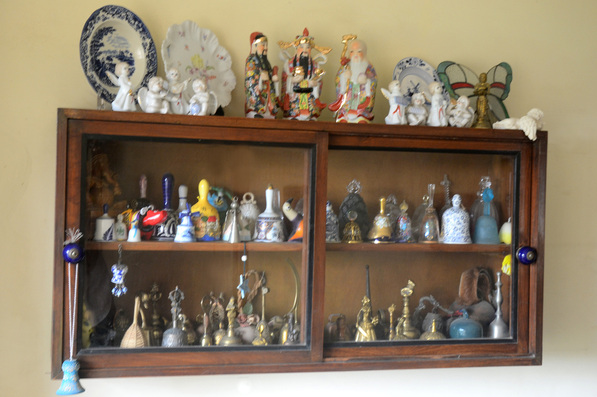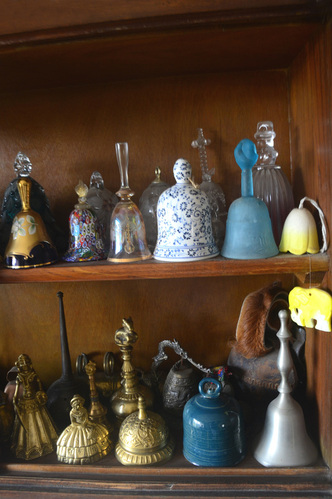|
As they trooped into the classroom for their creative writing class last week, I heard one boy say to another, “today a real author is coming to our class.”
“She’s already come!” Several interested glances were thrown in my direction. Many young readers are intrigued when they hear that I am a writer by profession, and they look at me with unabashed curiosity. Since most of their parents are probably doctors, engineers, chartered accountants or other hard working professionals, a person who spends her whole life making up stories about imaginary characters must seem quite an oddball to them. So, I usually get a lot of questions about what it’s like to be a writer. Last week I was asked why I decided to become a writer, and which my favourite book was, among the ones I’ve written. But none of these questions could top the one I was asked at a ‘Meet the Author’, session at a school some months ago. A little boy had just bought one of my books, and after I had signed it for him, he stared at the pile of books I had written, stacked up neatly on the desk. “Did you really write all these books?” he asked incredulously. “Yes,” I murmured quietly, uncertain where this was going. He looked me directly, and the flash of sympathy in his eyes was unmistakable. “Boy,” he said feelingly, rubbing his own little wrist. “How your hand must hurt!” In my interactions with them, I’ve noticed that children absorb, and notice many more things than adults do. During a creative writing class that I conducted one summer at a bungalow with a lovely garden, I noticed a charming statue of an angel nestled among the plants. On an impulse, I told my students to write a story that included the angel, and pointed out a tree and a wall that also had to figure in the story. I allowed the children to go out of the classroom, to have a closer look at the angel and the tree. “What about the snail?” they asked me when they were back in their seats. “Do we have to put him in our story as well?” I was puzzled. “I don’t see a snail anywhere,” I murmured, nonplussed. “Where is the snail?” This was greeted with excited shrieks. “He’s on the tree!” We all trooped out of the classroom again, and when I bent my head to the eye level of a seven year old, I spotted a large brown garden snail slithering up the tree trunk leisurely, leaving a silvery trail behind him. The snail that had craftily hidden himself from my view was the star of the stories that were written that day! When I was teaching the children how to create a character, one of the exercises I gave them was to write a character sketch of themselves when they were sixty years old. There was a little silence after I announced this, and I quickly realized that when you are seven years old, the complexities of being sixty years old are very difficult to fathom. So, I asked some of the children to describe their grandparents, hoping that this would throw up some ideas that they could build upon. One little girl raised her hand, and said her great grandmother who was a hundred years old, lived with them. She explained that the elderly lady who was quite unwell, had no teeth, and had to be force-fed a liquid diet through a tube. The rest of the class listened to this commentary in silence, and there were no comments or further questions on this subject. However, when I read the submissions that were handed in to me, I realized what an impact the little girl’s brief account of her great grandmother had made. Almost every child had written that at the age of sixty, he or she would have strong teeth, and would be able to eat many different kinds of food. Some had even included a detailed list of the food items they would determinedly chomp at the age of sixty! When I was teaching the class how to create an imaginary monster, the suggestions on the attributes that a monster could have, came thick and fast. But one little girl really amused me with her query. With a long suffering expression she asked me, “Can I make my little brother the monster?” Another time, when I was teaching the same class, I told the children that to make their writing more descriptive and effective, they should try to expand their vocabulary, instead of using the same, common words repeatedly. I gave them an exercise on using synonyms, and as we went over the words orally, I asked my students to give me another word that meant ‘evil,’ after telling them to avoid words that are over used, like ‘bad’ and ‘mean.’ After a few minutes, one little girl put up her hand. “I know a word that means evil,” she said happily with a satisfied smile. “It’s “politician.”
1 Comment
A few days ago, when I was entering an apartment building, I spotted a pretty tortoise shell cat sunning itself on the steps.
“What’s his name?” I asked the building watchman interestedly. After a little silence, the watchman replied ‘Jok”, rolling his tongue over the unfamiliar syllables. I immediately clicked my fingers, and called out to the cat by this name. But not even by a twitch of his whiskers did the little creature indicate that he recognized this name. As the watchman shrugged apologetically, I entered the building with a rueful smile. When parents name a child, they are careful to choose a name that has a significant meaning, is easy to spell or pronounce, or matches with the child’s astrological birth star. However, when we get a pet, we don’t have to worry about these considerations, and so, most people let their imagination run wild, and give a new pet an interesting and exotic name guaranteed to be a conversation starter. But what most people do not realize is that their pet’s name is also going to be mispronounced by domestic servants and helps, traders, watchmen, dhobis, et al, and this sometimes has amusing results. Years ago, we owned a large dalmation named Pongo. Pongo was a friendly dog, but he took an instant dislike to a stout black rottweiler that used to stroll past our home every evening when he was out walking with his attendant. The mere sight of this dog was enough to send Pongo into paroxysms of rage, and it was amusing to watch Pongo’s fury grow whenever the dog came into view. One day, we asked the dog’s attendant what his name was. ‘Bunsee,’ he replied proudly. When we called the dog by this name, he immediately responded to it, and in time, we became friends with the dog. Pongo also learnt the dog’s name, and if it was uttered, even in the dead of the night, it elicited an angry and unfriendly growl from deep within his throat. Several months after we had first made Bunsee’s acquaintance, we met him one evening, accompanied, for a change, by his owners. We greeted the dog enthusiastically as usual, as his family stood by, watching. Then, as we got talking, they told us gently that their dog’s name was ‘Bouncy’! When I was a teenager living in Chennai, Tamilnad, I gave a new puppy I had just got, the short (and rather cute, I thought) name, ‘Sammy.’ Alas! I quickly found that this was a rather unhappy choice of name – all the local people, including our household helps, pronounced the puppy’s name as ‘saami’ which in Tamil, was a term of respect used for a religious teacher or elder. This name became particularly inappropriate as Sammy, a mongrel of indeterminate breed, grew up to be a boisterous, often ill-mannered, and at times, ferocious dog given to hiding behind our gatepost so that he could pounce on unsuspecting visitors. When my grand-daughter Apsara was about six months old, my daughter Sanjana rescued a small bedraggled pup from the road, and gave her a forever home. Since the naughty little pup kept running off with the baby’s diapers (the well known brand Huggies) she was named Huggy. The puppy grew up to be a rather large pet, but the cook, gardener, and other locals who interact with her daily, seem to have swallowed the ‘H’ in her name, for I hear them calling her cheerily as ‘Ugh-ee!’ One of Huggy’s many dog friends is a huge and regal German shepherd who lives in a neighbouring street. When Sanjana asked the help who walks the dog what the animal’s name was, she was informed that it goes by the monicker ‘Nike’. Sanjana assumed that this name was inspired by the iconic American sportswear company that takes its name from Nike, the Greek goddess of victory. She and Apsara continued to hail the magnificent dog by this name, till one day, when they met him walking with his owner. The lady was astonished to hear her dog being called Nike – her dog’s name, she explained politely, was inspired by a Russian name – he was called Nicolai! So now, I think that when I see that tortoiseshell cat again, I won’t call him Jock, Jack, or even Joke like I did the last time. I’ll try a French name – perhaps the little cat is called Jacques? I have been collecting bells for more than twenty years. I try to bring back a bell from every place that I travel to, so each of the bells in my collection brings back happy memories. Some of my bells are gifts from friends and family members, and some are flea market finds that I chanced upon. I do not buy every bell that I come across (my home would then be overrun with bells) but only buy those that appeal to me because of their unusual appearance, history, or sound. Here are some bells from my collection... Here's an excerpt from an article I wrote about bells for the Children's Digest magazine.
Bells are amongst the oldest manmade musical instruments in the world, and from the earliest times, the most basic use of bells was to call people to worship and prayer. In Ancient Greece, the ringing of bells announced that freshly caught fish had arrived at the market! In Rome, bells called the people to worship at temples, and sonorous bell ringing accompanied the funeral services of mighty Roman emperors. In times of war, bells were rung to alert the people when enemy forces were approaching the gates of a city or fort. Bells were also treasured in these civilizations as patriotic symbols or war trophies. In fact, one of the first acts of invaders was to silence the bells of conquered cities! The shapes of bells depend on their cultural environment, their intended use, and the materials used in their composition. All tower bells in the western world are tulip shaped with a sound bow, or a bulge near their rim. In East Asia, bells are barrel shaped. Chinese bells often have lotus shaped rims. Bells in Asia do not have a sound bow. It is interesting to note that almost all Asian bells have convex walls, so the sound of these bells is produced and focused within the bell itself. Bells made in the western Christian tradition however, are trumpet shaped, and so their sound reaches out, and can be heard over much longer distances. In India, large temple bell bells are made from ‘panchaloha’ which is an alloy made of gold, silver, copper, tin and lead, and are often crowned with images of popular deities like Hanuman or Ganesha, or mythical creatures like the Nandi Bull, or Garuda the great eagle. The pellet bell or ‘tiger bell’ is a spherical vessel with loose pellets rolling around inside. This bell, which is rather like a rattle, is of great antiquity, and is widely used in Asia. In India, Pakistan and Philippines these bells are used as a dance attribute. During the Mughal era in India, Emperor Humayun, hung a thick rope at the entrance of his magnificent palace at Agra. It was attached to a large bell, and Humayun a whimsical, but just king, decreed that if any of his subjects wanted justice from his monarch, all he had to do was ring the bell, and the Emperor himself would appear on his royal balcony to listen to the pleas! Many interesting anecdotes have been recorded in Indian history books about this particular idea of Humayun, and there is even one improbable, but fascinating tale of how the bell was once rung by a milking cow, who, desperate to be reunited with the newborn calf that had been wrested from her, decided to appeal to the Emperor himself! According to Hindu myth, when Shiva was performing his dance of bliss on Mount Kailash, a single bell from his anklet came loose, and rolled down the slopes of the lofty mountain peak. The sounds that it made as it rolled down – Tha-di-thom-nom- today form the basic syllables used in Indian dance. There's a famous line from the movie 'It's a Wonderful Life,' that explains why collectors like me are so enchanted by bells - "Everytime a bell rings, an angel gets its wings..." |
AuthorArchives
November 2018
Categories |




 RSS Feed
RSS Feed
